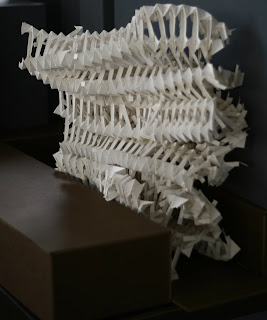













FINAL STATEMENT :
Overall, I found the process of creating a building system that would later emerge into a programmatic library, thought- provoking and enjoyable. Using the theory of emergence and studying self-organization in slime mold only made the process more engaging and stimulating. I feel the theory of emergence has a lot to contribute to the architectural world. After an in depth analysis and understanding of slime mold and its communicating system, I was able to collect data and formulate a complex pattern from the simple interactions of slime mold cells. Once my pattern was created I looked again, this time more intensely, toward the slime mold and how these basic single celled organisms transformed into a self organizing system. Using the slime molds binding signaling system, I formulated a method of folding and created a basic module that would produce an enclosure and tabbed joining system. The modules then evolved into multiple forms and scales based on program and site conditions. My final proposal was a library created from a wide variety of modular parts. My vision was of pre-fabricated modules that would attach together based on my tabbed system and a catalogue of parts. Furthermore, the theory of emergence and self-organization became an excellent thinking tool in establishing a building system. However, if I could take my process further it would be to develop a method of making my modules less static. With more time I envision a building system that interacts with its environment much like slime mold does. A module that is dynamic and creates shade when it is needed or light where it is desired. These are the interactions that I believe can influence the architectural world. If we can translate the same sensitivity slime mold cells have to light and other environmental conditions then we could produced an architecture that is beneficial to creating better living.
-Dominick Casale

















.gif)
.gif)
.gif)

























